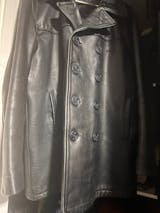What You're Really Sitting On

The image above shows a common sight in many vehicles: cracked, peeling, and failing vinyl. At a glance, it may appear to be worn-out leather—but this is not leather at all. It’s vinyl, also known as synthetic leather or PVC upholstery, and this type of damage is a revealing insight into the shortcomings of vinyl when compared to genuine leather.
What Is Vinyl Upholstery?
Vinyl (short for polyvinyl chloride or PVC) is a plastic-based material often used in automotive interiors as a cheaper alternative to leather. It is made by applying a plasticised topcoat onto a fabric or foam backing, which is then embossed to mimic the look and texture of leather.
Manufacturers favour vinyl for its low cost, water resistance, and initial aesthetic appeal—but what they often overlook (or downplay) is the drastically shorter lifespan and poor repair performance compared to genuine leather. Cleaning vinyl can be carried out with dedicated vinyl cleaners.
How Vinyl Is Made—and Why That’s a Problem
Vinyl production is far from eco-friendly. It begins with petroleum, which is turned into ethylene, then polymerised into PVC. To make it soft and flexible, chemical plasticisers—most commonly phthalates—are added. These substances have raised significant environmental and health concerns. Vinyl manufacturing contributes to toxic waste and emits harmful compounds such as dioxins during production and incineration.
Even worse, vinyl is non-biodegradable. Once it reaches the end of its life—often prematurely due to cracking like in the image above—it cannot be composted or safely recycled. Instead, it ends up in landfills or incinerators, leaching chemicals into the environment.
Durability: The Cracking Reality
The photo clearly shows how vinyl behaves over time: it becomes brittle, cracks, and eventually splits entirely, exposing the foam backing underneath. Unlike leather, vinyl doesn't develop a patina or age gracefully. Once the topcoat fails, there’s little that can be done to restore it convincingly.
Vinyl is highly vulnerable to:
- UV damage
- Temperature fluctuations
- Chemical breakdown of plasticisers
- Loss of elasticity over time
This means that even with careful maintenance, vinyl often deteriorates within a few short years—especially in high-contact areas such as armrests, seat bolsters, or steering wheels.
Repair Limitations of Vinyl
Repairing vinyl is notoriously difficult. While genuine leather can be cleaned, recoloured, nourished, and restored for decades, vinyl tends to resist bonding materials. Repair attempts may temporarily conceal cracks or holes, but due to the material’s nature, these fixes usually fail under stress or flex.
Once cracking begins, the surrounding material becomes unstable, making it difficult for any filler or colour coating to hold effectively. In many cases, the only true “repair” is full replacement of the panel or seat covering.
Vinyl vs. Genuine Leather: A Critical Comparison
|
Feature |
Vinyl (PVC) |
Genuine Leather |
|
Cost |
Lower upfront |
Higher upfront |
|
Lifespan |
3–5 years (typical) |
10–30+ years with care |
|
Repairability |
Poor |
Excellent |
|
Appearance over time |
Cracks and peels |
Develops rich patina |
|
Environmental Impact |
High (non-biodegradable) |
Lower (natural material, longer use) |
|
Comfort |
Less breathable |
Naturally breathable |
Sustainable and Smarter Choices
For vehicle owners, detailers, or restorers, investing in genuine leather—or at the very least, understanding the limitations of vinyl—is essential for long-term satisfaction. Vinyl may offer an affordable shortcut at first, but it often leads to premature degradation, aesthetic decline, and environmental waste.
If you currently own a car with vinyl upholstery, protect it with UV blockers, gentle cleaners, and avoid harsh steam or chemical treatments. However, if you're considering a restoration or upgrade, genuine leather remains the superior option in both form and function.
Want expert advice or professional restoration for damaged interiors like this?
Our team specialises in leather identification, repair, and sustainable alternatives. Let us help you bring quality back into your vehicle—without the cracks and compromises.






